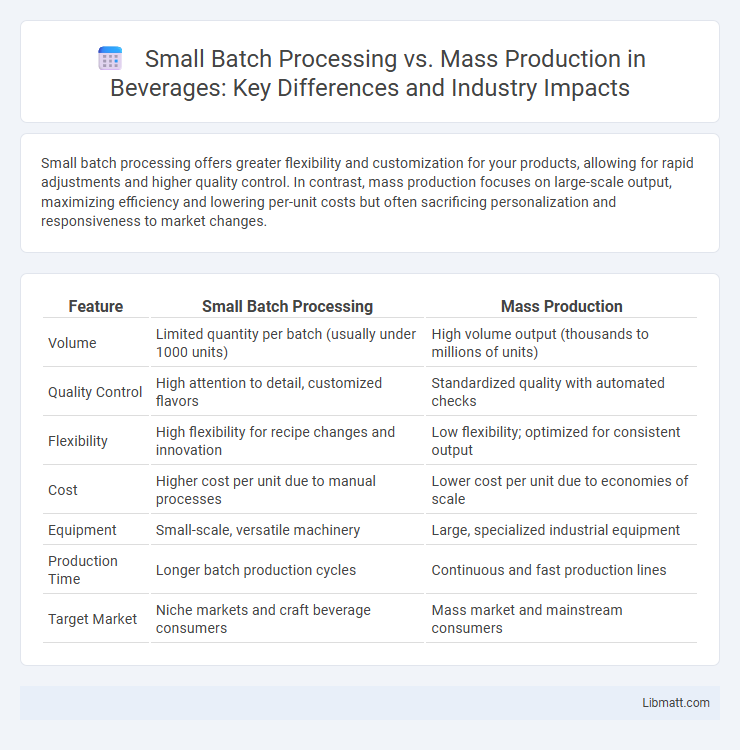Small batch processing offers greater flexibility and customization for your products, allowing for rapid adjustments and higher quality control. In contrast, mass production focuses on large-scale output, maximizing efficiency and lowering per-unit costs but often sacrificing personalization and responsiveness to market changes.
Table of Comparison
| Feature | Small Batch Processing | Mass Production |
|---|---|---|
| Volume | Limited quantity per batch (usually under 1000 units) | High volume output (thousands to millions of units) |
| Quality Control | High attention to detail, customized flavors | Standardized quality with automated checks |
| Flexibility | High flexibility for recipe changes and innovation | Low flexibility; optimized for consistent output |
| Cost | Higher cost per unit due to manual processes | Lower cost per unit due to economies of scale |
| Equipment | Small-scale, versatile machinery | Large, specialized industrial equipment |
| Production Time | Longer batch production cycles | Continuous and fast production lines |
| Target Market | Niche markets and craft beverage consumers | Mass market and mainstream consumers |
Introduction to Small Batch Processing and Mass Production
Small batch processing involves producing limited quantities of products, allowing for greater customization, flexibility, and quality control. Mass production focuses on large-scale manufacturing to maximize efficiency and reduce per-unit costs through standardized processes and automation. Your choice between these methods depends on factors such as demand variability, product complexity, and cost considerations.
Key Differences Between Small Batch Processing and Mass Production
Small batch processing involves producing limited quantities of products, emphasizing flexibility, customization, and higher quality control, making it ideal for specialized or niche markets. Mass production focuses on large-scale output with standardized processes to maximize efficiency, reduce costs, and meet high demand consistently. Your choice between these methods depends on factors like production volume, product complexity, and market needs.
Advantages of Small Batch Processing
Small batch processing offers greater flexibility and customization, allowing manufacturers to quickly adapt to changing market demands and produce niche products. It reduces inventory costs and minimizes waste by producing only what is needed, enhancing overall efficiency. Enhanced quality control is achieved through closer monitoring of each batch, leading to higher product consistency and customer satisfaction.
Benefits of Mass Production Techniques
Mass production techniques significantly reduce unit costs through economies of scale, enabling businesses to produce large quantities of goods rapidly and consistently. Standardized processes and automation enhance product quality and uniformity, minimizing defects and waste. This approach also supports faster market delivery and strengthens supply chain efficiency, meeting high consumer demand effectively.
Cost Implications: Small Batch vs Mass Production
Small batch processing typically incurs higher per-unit costs due to limited economies of scale and increased setup times, making it less cost-effective for large volume manufacturing. Mass production benefits from bulk purchasing, streamlined workflows, and automation, significantly reducing the cost per unit and maximizing profit margins. Businesses must weigh initial investment and operational efficiency when choosing between small batch and mass production for cost optimization.
Flexibility and Customization in Production Methods
Small batch processing offers superior flexibility and customization by allowing manufacturers to quickly adapt designs and produce limited quantities tailored to specific customer requirements. Mass production emphasizes efficiency and uniformity, making it ideal for standardized products but less capable of accommodating unique or rapidly changing specifications. Businesses seeking to balance cost with responsiveness often leverage small batch methods to meet niche demands without sacrificing quality.
Quality Control: Batch Processing vs Mass Production
Small batch processing offers enhanced quality control by allowing closer inspection and adjustments throughout smaller production runs, reducing the risk of defects. Mass production relies on standardized processes and automated systems to maintain consistent quality, but defects can go unnoticed until larger quantities are produced. Your choice between these methods impacts how precisely quality issues are detected and resolved during manufacturing.
Environmental Impact: Which is More Sustainable?
Small batch processing significantly reduces waste and energy consumption compared to mass production, making it a more sustainable choice for environmentally conscious manufacturers. Mass production often relies on large-scale resource use and generates excess inventory, leading to higher carbon footprints and landfill contributions. By choosing small batch processing, you can minimize environmental impact through efficient material usage and lower emissions.
Industry Applications: When to Use Small Batch or Mass Production
Small batch processing is ideal for industries requiring customization, rapid prototyping, or limited product runs, such as craft breweries, specialty food makers, and bespoke electronics. Mass production suits high-demand sectors like automotive manufacturing, consumer electronics, and packaging, where large volumes reduce unit costs and improve consistency. Understanding your industry's scale and market needs helps determine whether small batch flexibility or mass production efficiency best supports your operational goals.
Choosing the Right Approach for Your Business
Small batch processing offers flexibility and customization, making it ideal for businesses targeting niche markets or requiring rapid product iteration. Mass production excels in cost efficiency and high-volume output, suitable for businesses with established demand and standardized products. Evaluating your product complexity, market size, and production goals will help you choose the right approach to optimize profitability and customer satisfaction.
Small batch processing vs mass production Infographic

 libmatt.com
libmatt.com